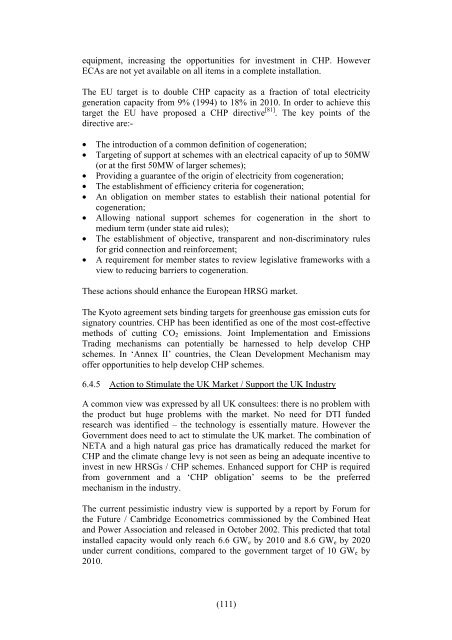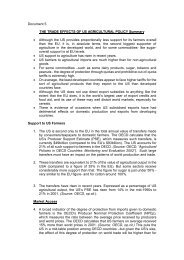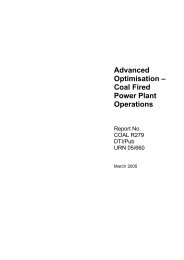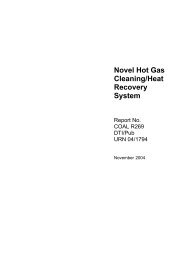(70) Therefore, the risk of sulphuric acid dew point attack ... - DTI Home
(70) Therefore, the risk of sulphuric acid dew point attack ... - DTI Home
(70) Therefore, the risk of sulphuric acid dew point attack ... - DTI Home
Create successful ePaper yourself
Turn your PDF publications into a flip-book with our unique Google optimized e-Paper software.
equipment, increasing <strong>the</strong> opportunities for investment in CHP. However<br />
ECAs are not yet available on all items in a complete installation.<br />
The EU target is to double CHP capacity as a fraction <strong>of</strong> total electricity<br />
generation capacity from 9% (1994) to 18% in 2010. In order to achieve this<br />
target <strong>the</strong> EU have proposed a CHP directive [81] . The key <strong>point</strong>s <strong>of</strong> <strong>the</strong><br />
directive are:-<br />
• The introduction <strong>of</strong> a common definition <strong>of</strong> cogeneration;<br />
• Targeting <strong>of</strong> support at schemes with an electrical capacity <strong>of</strong> up to 50MW<br />
(or at <strong>the</strong> first 50MW <strong>of</strong> larger schemes);<br />
• Providing a guarantee <strong>of</strong> <strong>the</strong> origin <strong>of</strong> electricity from cogeneration;<br />
• The establishment <strong>of</strong> efficiency criteria for cogeneration;<br />
• An obligation on member states to establish <strong>the</strong>ir national potential for<br />
cogeneration;<br />
• Allowing national support schemes for cogeneration in <strong>the</strong> short to<br />
medium term (under state aid rules);<br />
• The establishment <strong>of</strong> objective, transparent and non-discriminatory rules<br />
for grid connection and reinforcement;<br />
• A requirement for member states to review legislative frameworks with a<br />
view to reducing barriers to cogeneration.<br />
These actions should enhance <strong>the</strong> European HRSG market.<br />
The Kyoto agreement sets binding targets for greenhouse gas emission cuts for<br />
signatory countries. CHP has been identified as one <strong>of</strong> <strong>the</strong> most cost-effective<br />
methods <strong>of</strong> cutting CO2 emissions. Joint Implementation and Emissions<br />
Trading mechanisms can potentially be harnessed to help develop CHP<br />
schemes. In ‘Annex II’ countries, <strong>the</strong> Clean Development Mechanism may<br />
<strong>of</strong>fer opportunities to help develop CHP schemes.<br />
6.4.5 Action to Stimulate <strong>the</strong> UK Market / Support <strong>the</strong> UK Industry<br />
A common view was expressed by all UK consultees: <strong>the</strong>re is no problem with<br />
<strong>the</strong> product but huge problems with <strong>the</strong> market. No need for <strong>DTI</strong> funded<br />
research was identified – <strong>the</strong> technology is essentially mature. However <strong>the</strong><br />
Government does need to act to stimulate <strong>the</strong> UK market. The combination <strong>of</strong><br />
NETA and a high natural gas price has dramatically reduced <strong>the</strong> market for<br />
CHP and <strong>the</strong> climate change levy is not seen as being an adequate incentive to<br />
invest in new HRSGs / CHP schemes. Enhanced support for CHP is required<br />
from government and a ‘CHP obligation’ seems to be <strong>the</strong> preferred<br />
mechanism in <strong>the</strong> industry.<br />
The current pessimistic industry view is supported by a report by Forum for<br />
<strong>the</strong> Future / Cambridge Econometrics commissioned by <strong>the</strong> Combined Heat<br />
and Power Association and released in October 2002. This predicted that total<br />
installed capacity would only reach 6.6 GWe by 2010 and 8.6 GWe by 2020<br />
under current conditions, compared to <strong>the</strong> government target <strong>of</strong> 10 GWe by<br />
2010.<br />
(111)
















